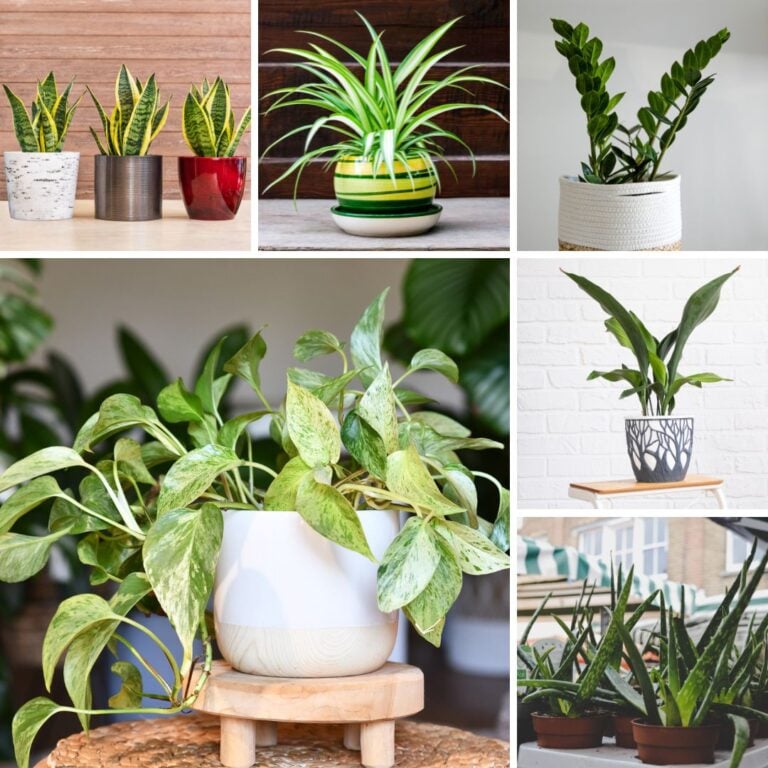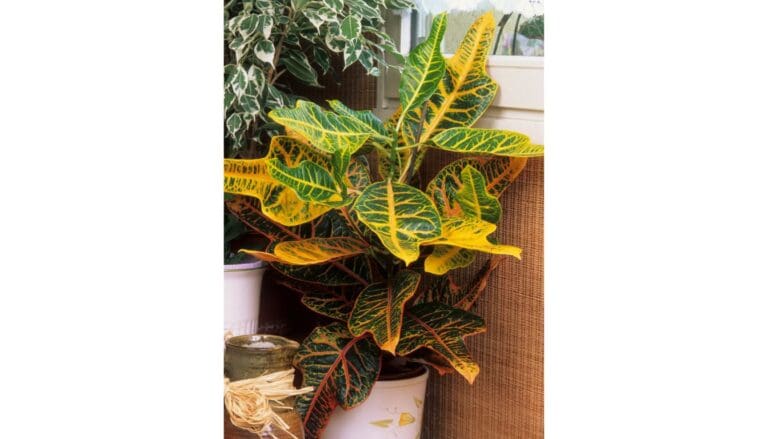15 Best Flowers That Bloom All Year
I really enjoy keeping my garden colorful, no matter what the weather’s doing. Flowers that bloom all year make everything feel lively—even when it’s chilly or gray outside.
It’s just nice to have fresh color and beauty every month, instead of waiting around for spring.
Here, I’ll share some of my favorite flowers that keep blooming through every season. You’ll also find simple care tips and design ideas that make it easier to keep your garden looking good all year.
Please note: Simplify Plants is reader-supported. As an Amazon Associate, I earn from qualifying purchases made by our readers with no extra cost added to you all! Some links in the post are affiliate links and I get a commission from purchases made through links in the post.
1) Camellia japonica

Camellia japonica is a plant I keep coming back to. It brightens up my garden even when most other plants are taking a break.
This evergreen shrub has glossy green leaves and those elegant blooms that stick around for much of the year. I notice its flowers in all sorts of shades—pink, red, and white—with soft, layered petals.
The blooms really pop against the dark foliage, so the plant always looks fresh. Camellias seem happiest in mild climates with a bit of shade, at least in my experience.
I plant them in well-drained, slightly acidic soil and try to shield them from harsh afternoon sun. Too much direct light can be a problem, so I keep an eye on that.
Watering is important, but I avoid soaking the roots. Consistent moisture helps the buds open up nicely. A little balanced fertilizer in spring usually means more blooms later.
What I really like is how long the flowers last. Some blossoms hang on for weeks before they finally fade. Sometimes I snip a few to bring inside—they look great in a vase.
People always notice Camellia japonica’s tidy shape and steady color. It fits in formal gardens, small patios, and even containers. It grows slowly, so it never gets out of hand.
After it finishes flowering, I do a bit of light pruning to tidy things up and help new growth along. Removing old or damaged branches lets air move through, which keeps the leaves glossy and healthy.
I think Camellia japonica just adds this calm, steady beauty all year. Its leaves and blooms remind me that color doesn’t have to disappear with the seasons.
2) Kalanchoe blossfeldiana

There’s something cheerful about Kalanchoe blossfeldiana. It keeps those bright flower clusters for weeks, even months, if I give it the right care.
I usually keep mine near a sunny window—bright, indirect light seems to be the sweet spot. Too much sun burns the leaves, but not enough light means fewer blooms. It took a little trial and error to figure that out.
I water only when the top inch of soil is dry. Overwatering can cause root rot, so I make sure the pot drains well. Those thick, fleshy leaves store water, which is perfect if you’re forgetful like me.
The flowers come in all kinds of colors—red, pink, yellow, orange, white. I like mixing a few shades together for a happier display. The glossy leaves help the blooms stand out, too.
When the flowers fade, I trim the stems back. With enough light and a bit of patience, it often blooms again, even indoors. A short rest period between blooming helps it bounce back with stronger flowers.
Since it’s compact, I can put it on my desk or windowsill without losing space. It works well in small pots or mixed arrangements. Kalanchoe blossfeldiana brings color and life to my home, no matter what time of year it is.
3) Lantana camara

Lantana camara is a real workhorse for year-round color. Its little clusters of flowers attract butterflies and bees, which makes the yard feel alive.
The blooms come in yellow, orange, pink, red, and purple, sometimes all on one plant. It grows best in warm, sunny spots and barely needs any care.
I water it only when the soil is dry, and it still keeps blooming. It handles heat and drought better than most flowers I’ve tried, honestly.
Lantana works in pots or straight in the ground. It spreads out, so I trim it now and then to keep things tidy. The leaves have a light scent—kind of a nice bonus.
It fills empty spaces and pairs well with other low-maintenance plants like marigolds or zinnias. Its long-lasting blooms make it a solid pick if you want color without a lot of work.
In my experience, full sun and well-drained soil are key. Overwatering can cause root problems, so I go easy there. With just a little attention, Lantana camara keeps blooming month after month.
4) Geranium (Pelargonium)

Geraniums are just classic. They stay bright and colorful for most of the year, and the blooms come in red, pink, white, and purple—easy to match with almost anything.
I find them easy to care for. Plenty of sunlight and watering when the soil’s dry is all they really ask for. Well-drained soil helps, and they don’t mind a little drought.
Trimming old flowers brings new ones quickly. That keeps things tidy and encourages more blooms. Geraniums can handle both indoor and outdoor life, as long as they get enough light.
Geraniums add color all year in warm climates, and they can bloom indoors when it’s cold out. I often bring potted Geraniums inside before winter—they make the place feel cheerful.
There’s a lot of variety, too. Some have scented leaves—lemon, rose, things like that—while others have bold patterns or different leaf shapes. It’s fun to mix and match.
To keep them healthy, I feed my Geraniums with balanced fertilizer now and then. I also check for pests like aphids or whiteflies. With simple care, they just keep going.
Geraniums are reliable and versatile. They bring steady color, don’t ask for much, and brighten up any spot.
5) Hellebore (Christmas Rose)

Hellebores are kind of magical when the rest of the garden looks sleepy. These tough perennials bloom in late winter and early spring, sometimes even through snow.
Their flowers are elegant and subtle—soft shades of white, pink, purple, and green. Each bloom faces a bit downward, which gives them a gentle look.
The petals last for weeks, fading slowly but always looking pretty. Hellebores thrive in partial shade and like rich, well-drained soil.
Once they’re settled, they barely need any care. I just water them during dry spells and pick off old leaves to keep things neat.
They stay evergreen in a lot of places, so I get to enjoy their deep green leaves all year. Deer and rabbits leave them alone, which is a relief. Over time, they form tidy clumps and don’t take over the garden.
I usually plant Hellebores near paths or entryways so I can see their blooms up close. Their quiet beauty is a nice reminder that the garden’s never really asleep. The Christmas Rose really does brighten up winter days.
6) Ixora coccinea
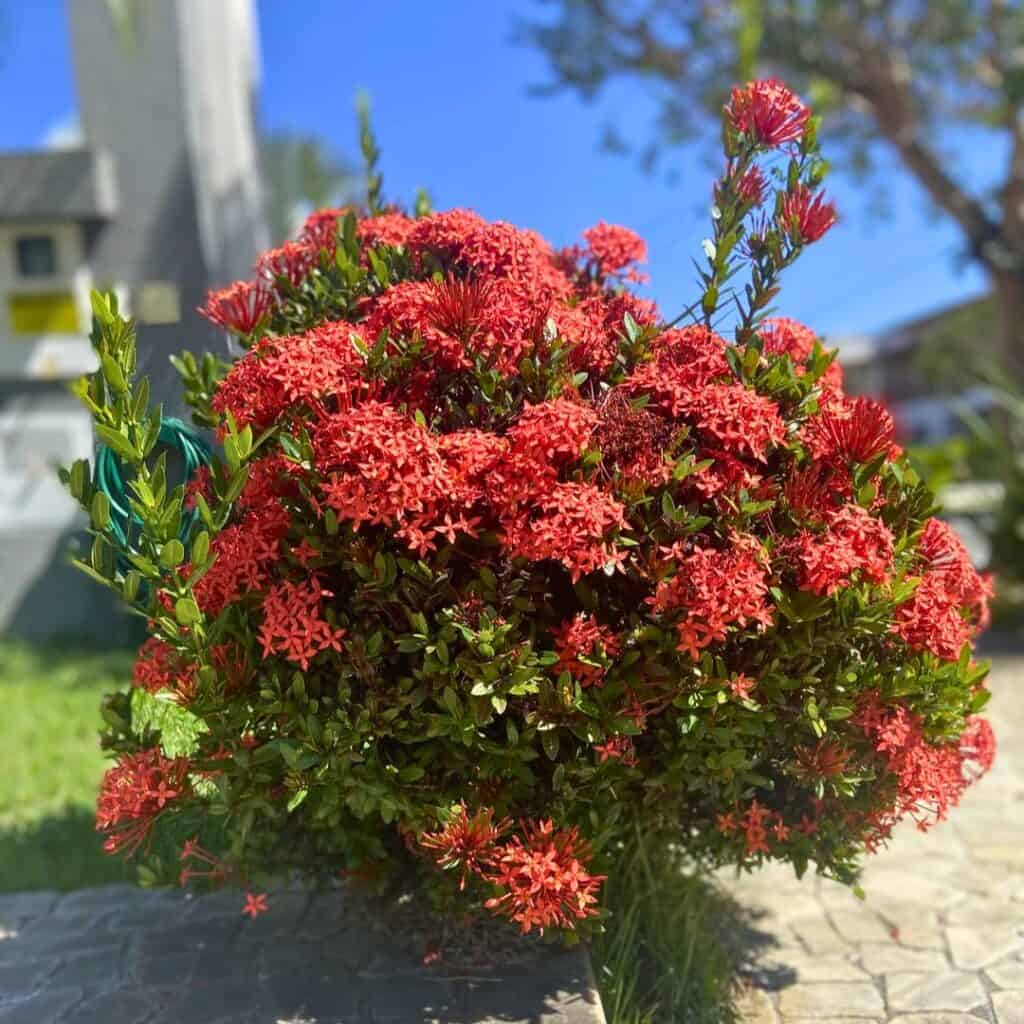
Ixora coccinea—sometimes called Jungle Geranium or Flame of the Woods—is a favorite of mine for nonstop color. Its little star-shaped flowers gather in clusters and look amazing all year in warm places.
The blooms show up in red, orange, pink, and yellow, so I can play around with color themes. The shiny green leaves make those flowers pop even more.
It’s pretty easy to grow if you give it full sun and well-drained soil. Regular watering keeps it happy, but I let the soil dry a bit between drinks. A monthly dose of compost helps, too.
Light pruning keeps it neat and encourages more blooms. I use it as a border plant or in containers near the patio. Butterflies and sometimes bees love it, which adds some life to the garden.
Ixora likes warm, humid weather and really hates the cold. In cooler areas, I bring it inside or tuck it in a greenhouse for winter.
With the right care, this plant stays green and colorful most of the year. Its constant blooms make it a top pick for a cheerful, low-maintenance garden.
7) Bougainvillea glabra

Bougainvillea glabra is just instant color, honestly. Its bright, papery bracts look like flowers, but the real blooms are those tiny white centers.
I see it climbing walls and trellises, making a bold splash of pink, purple, or red. It grows quickly and loves warm, sunny climates. With enough sunlight, it’ll bloom almost all year.
This plant barely needs water once it’s settled in. I let the soil dry out between waterings—too much water causes root trouble. Good drainage is important.
Bougainvillea glabra handles dry conditions and poor soil just fine. It’s a solid choice if you don’t want to fuss over your plants. A little pruning helps shape it and keeps the flowers coming.
If I grow it in a pot, I use something sturdy because the roots get strong. It needs some support, like a fence or trellis, to really show off.
The best part? It stays colorful for ages. Even when other plants fade, Bougainvillea glabra keeps blooming with enough light. It’s hands-down one of my favorites for lasting brightness.
8) Vinca minor (Periwinkle)

I’ve always loved how Vinca minor, or Periwinkle, manages to keep its charm no matter the season. Even in winter, those small, glossy green leaves stay bright and cheerful when most plants just give up.
Every spring, I spot its delicate purple-blue flowers peeking out, and sometimes they surprise me again in fall. The blooms aren’t big, but they really pop against the dark green leaves.
I like using Periwinkle as a ground cover since it spreads fast and forms a neat little carpet. It’s great for keeping weeds down and stopping soil from washing away after a heavy rain.
This plant seems happiest in partial shade, though it can handle some sun. Honestly, I don’t fuss over it much—after it’s settled in, it barely needs watering and isn’t picky about soil.
Once or twice a year, I give it a quick trim to keep things tidy. That’s pretty much all it asks for, which is probably why it’s one of my go-to plants for year-round greenery.
I think Periwinkle looks fantastic along pathways, under trees, or on slopes. It just gives those awkward spots a soft, natural vibe without much effort. And the best part? It stays green and lively, no matter what the weather’s doing.
9) Gardenia jasminoides

There’s something about Gardenia jasminoides, or Cape jasmine, that just makes a garden feel special. The sweet scent drifts through the air, and those creamy white flowers against glossy green leaves give everything a calm, classy look.
I’ve noticed gardenias really thrive in warm, humid climates. They like partial shade and well-drained, acidic soil—not too fussy, but they do want the soil just moist enough, never soggy.
In mild regions, gardenias can bloom through most of the year. Indoors, I keep mine near a bright window with filtered sunlight. I’ll mist the leaves now and then to keep humidity up, which helps prevent leaf drop.
I like planting gardenias in containers or near entryways so their fragrance greets me (and guests) right away. The blooms also look great as cut flowers—I’ll sometimes pop a few in a vase indoors.
Feeding gardenias with a balanced fertilizer every few weeks during the growing season keeps the leaves glossy and the buds opening. After flowering, a bit of pruning helps keep the plant neat and bushy.
Honestly, gardenias just add a classic charm wherever they’re planted. With a little attention, they reward you with fresh blooms and that lovely scent for most of the year.
10) Bouvardia ternifolia

Bouvardia ternifolia, or firecracker bush, is such a fun plant for adding bright color almost all year. Those small, tubular red or orange flowers stand out against the green leaves and always seem to bring in hummingbirds and butterflies.
I’ve found it blooms best in warm, sunny spots. Whether in garden beds or containers, it’s pretty easygoing if you give it well-drained soil and regular watering.
Once established, it can handle short dry spells. Still, I try not to let it dry out too much, especially when it’s hot out.
This plant usually stays compact, about 2 to 4 feet tall. I give it a light trim to keep its shape and encourage more blooms—pruning after each flowering cycle seems to help.
I’ve seen how much pollinators love this plant. Those bright flowers really liven up my garden, even when other plants take a break.
Because it keeps flowering for so long, I see Bouvardia ternifolia as a solid pick for low-maintenance color. It fits right in with borders, rock gardens, or mixed flower beds.
I also like putting it near patios or windows so I can actually enjoy the blooms up close. The flowers last ages and just make everything feel more cheerful.
When I plant Bouvardia ternifolia, I always aim for full sun. Too much shade means fewer flowers and lanky stems—not ideal.
It does best in mild climates, but if frost is coming, I’ll bring it inside or cover it up. A little protection in winter keeps it going strong once things warm up again.
Adding a thin layer of mulch really helps keep the soil moist and cuts down on weeds. It’s a small step, but it makes a noticeable difference.
11) Fuchsia magellanica

I can’t get enough of how Fuchsia magellanica brings color to my garden for months on end. Those hanging, tube-shaped flowers—like tiny lanterns in pink, red, and purple—always attract hummingbirds and butterflies, making the whole yard feel alive.
This plant does especially well in cool, mild climates. I’ve learned it likes partial shade and moist, well-drained soil. If I keep the soil just damp, the blooms stick around much longer.
I prune my fuchsia in early spring to keep it looking tidy and to encourage new growth. It can turn into a small shrub, anywhere from 3 to 10 feet tall, depending on the type. The thin branches and green leaves give it a really delicate vibe.
Even though it’s pretty tough, I still protect it from frost in winter. A layer of mulch helps keep the roots cozy. In warmer spots, it can stay evergreen and just keep blooming.
I like using Fuchsia magellanica in borders, pots, or even hanging baskets. The long flowering season and graceful shape make it one of my favorites. It’s the kind of plant that keeps giving color when most others have faded.
12) Polyanthus primrose

Polyanthus primroses never fail to brighten up my garden, even when everything else looks tired. These compact flowers come in so many colors—yellow, pink, red, purple—that it’s hard not to smile when you see them.
I plant them in cool, partially shaded spots where the soil stays moist (but not soggy). They love well-drained, rich soil with plenty of organic matter. I try to keep the watering regular so the roots stay happy.
Polyanthus primroses bloom for ages, often from late winter into spring. In mild climates, they’ll even flower almost all year. Picking off old blooms keeps them going longer.
They look great in containers, borders, and window boxes. I like mixing the colors for a really lively display. Their compact size means I can tuck them into small spots, too.
Another thing I love is how easy they are to care for. As long as I water them and keep them out of harsh heat, they stay strong and colorful. A little care really goes a long way with these guys.
On chilly days, seeing their fresh, bright blooms always lifts my mood. Polyanthus primroses bring steady color and charm through every season.
13) Wax Begonia

Wax Begonias are a personal favorite because they just keep their color, no matter the season. The shiny green or bronze leaves always look healthy, whether it’s hot or cool. Their small blooms in pink, red, or white add instant brightness anywhere.
I plant them in pots or garden beds since they’re pretty flexible about sun or partial shade. They don’t need much fussing—just regular watering and keeping the soil a little moist is enough.
Wax Begonias stay neat and compact, usually around 6 to 12 inches tall. Their tidy shape makes them perfect for borders, patios, or window boxes. I like how they fill empty spots without taking over.
They handle heat and humidity better than lots of other flowers. In mild climates, they’ll bloom all year. If it gets cold, I’ll bring them inside or just grow them as houseplants to keep the color going.
Trimming off old flowers helps them keep blooming. A bit of fertilizer every few weeks keeps the leaves glossy and the blooms popping. It’s a simple routine that really works.
Wax Begonias also mix well with other plants. I like pairing them with coleus or impatiens for a splash of extra color. Their sturdy stems and shiny leaves make any arrangement look fresh.
If you want a low-maintenance flower that just stays colorful, I always recommend Wax Begonias. They’re easy, tidy, and bring steady beauty wherever they’re planted.
14) Jasmine (Jasminum sambac)
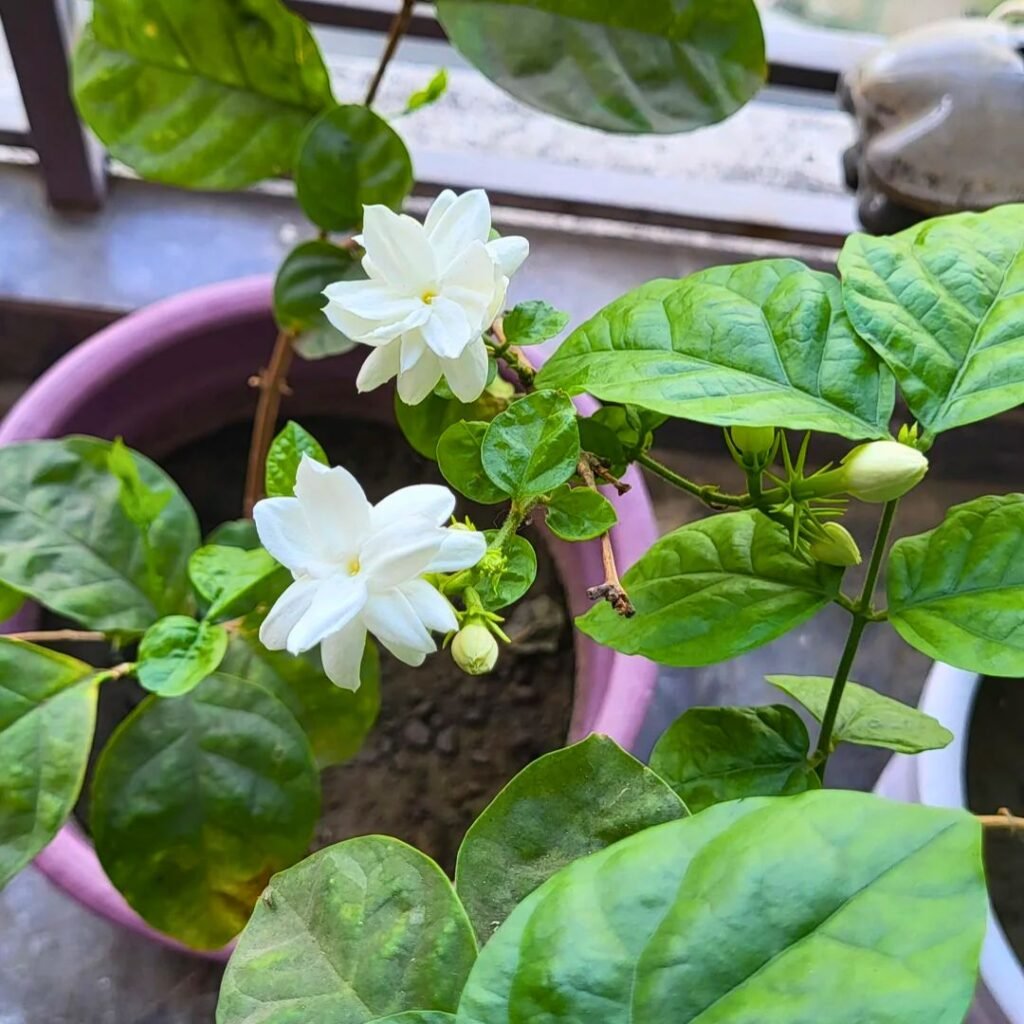
There’s nothing quite like the way Jasmine fills the air with its sweet scent, especially in the evening. The small white flowers are simple but stand out against those deep green leaves. I find it easy to grow and super rewarding since it blooms so often.
I usually put Jasmine in a sunny spot that gets at least six hours of light. It does well in containers, too, which is perfect for patios or balconies. With regular watering and a bit of light pruning, it stays healthy and loaded with blooms.
What I love most is how Jasmine attracts pollinators like bees and butterflies. It really livens up the garden while keeping everything fragrant. The flowers open in cycles, so there’s almost always something new to enjoy.
I’ve noticed Jasminum sambac likes warm temperatures and well-drained soil. In colder months, I’ll bring potted plants inside to protect them from frost, and that helps keep them green and ready to bloom again when it warms up.
Lots of people use Jasmine flowers in teas and perfumes for their gentle fragrance. Sometimes I’ll float a few blossoms in a bowl of water indoors—it’s a simple way to freshen up a room and bring a bit of the garden inside.
15) Azalea (Rhododendron indicum)
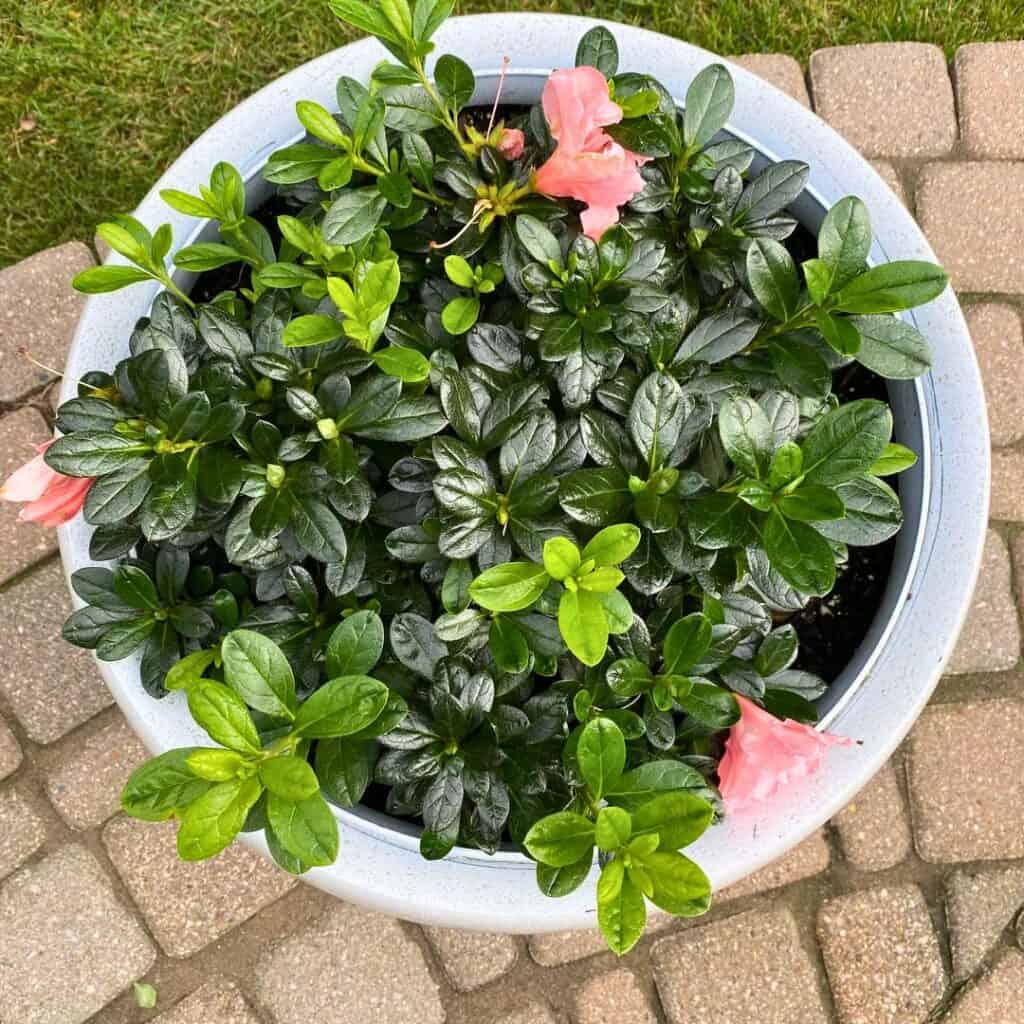
I just love how Azaleas splash color across my garden, almost all year. Their bright blooms really steal the show in spring, but if you give them the right care, some varieties just keep going through several seasons.
They really liven up any yard—there’s something fresh about seeing those pops of color outside my window. I’ve noticed Azaleas prefer partial shade and soil that drains pretty well.
When I tuck them into spots with morning sun and a bit of afternoon shade, they seem happiest and just burst with flowers. Too much hot sun tends to dry out the leaves or wash out the colors, so I try to avoid that.
Watering is a bit of a balancing act—I keep the soil moist but never soggy. Moist, slightly acidic soil seems to be their sweet spot.
I usually throw some mulch around the base to help hold in moisture and keep those pesky weeds down. It honestly cuts down on maintenance and makes everything look tidier.
Pruning after blooming is a habit I’ve picked up. Just a light trim to shape things up and snip off any dead bits.
It keeps my Azaleas compact and encourages more flowers. I’m a fan of the variety, too—Azaleas come in pink, red, white, and purple.
Every color brings a different vibe. When I group them, they create this soft, colorful border that still looks nice most of the year.
In milder spots, I’ve seen Azaleas surprise me with blooms in late summer or even fall. Evergreen varieties keep their leaves, so there’s still greenery when most other plants check out.
That alone makes them a solid pick for year-round interest. I often pair Azaleas with ferns or hostas.
Their textures just work together, and they like similar conditions. This mix gives my garden some easy layers of color and shape without a ton of work.
How to Care for Year-Round Blooming Flowers
For me, keeping flowers healthy comes down to three basics—good soil, enough sunlight, and regular feeding. These are the things I always pay attention to if I want blooms all year.
Soil and Watering Essentials
I always start with well-draining soil. Soggy roots? That’s a no-go. A mix of loam, compost, and perlite seems to do the trick for most flowers.
I just poke my finger in the dirt—if it’s dry an inch down, it’s probably time to water. I water deeply but not too often so roots grow strong and don’t just hang out at the surface.
Room-temperature water feels safest for the roots, honestly. For containers, I make sure there are drainage holes—standing water is bad news.
I usually sprinkle a thin layer of mulch on top to keep moisture in and cut down on watering. Here’s a quick guide I go by:
| Flower Type | Watering Frequency | Soil Type |
|---|---|---|
| Tropical varieties | Every 2–3 days | Rich, moist soil |
| Drought-tolerant | Once a week | Sandy, well-drained |
| Indoor blooms | When top inch is dry | Light potting mix |
Sunlight Requirements
Getting sunlight right is key. Most year-round bloomers want at least 6 hours of direct light daily.
I put sun-lovers by south-facing windows or out in the open. If a plant starts getting leggy or pale, I shuffle it to a brighter spot.
For indoor flowers, I’ll use grow lights during gloomy winter days. I rotate pots every couple of weeks so all sides get their fair share of light.
It helps them grow straight and balanced. Shade-lovers like impatiens? They’re happier with filtered light or just a bit of morning sun.
Fertilizing Tips
Feeding is simple enough. I stick with a balanced fertilizer—equal parts nitrogen, phosphorus, potassium, like 10-10-10.
Every 4 to 6 weeks during growth spurts is usually enough. Overdoing it can burn roots, so I always check the label first.
Potted plants need a little extra care; I flush the soil with plain water once a month to clear out salt. Compost is a favorite of mine, too—it slowly improves the soil and gives a steady feed.
I mix in a bit around each plant and water it in. If leaves look pale or growth stalls, I tweak my feeding schedule a bit.
Design Ideas for All-Season Flower Gardens
I’m always mixing plants that bloom at different times, so there’s color no matter what month it is. I also pay attention to how flowers, leaves, and containers play off each other for year-round interest.
Combining Colors and Textures
When I plan, I like to group flowers with contrasting colors and leaf shapes. Yellow marigolds next to purple salvia? That’s a combo I keep coming back to.
Mixing soft petals with spiky foliage makes each area pop. I use a simple color guide to avoid clashing:
| Color | Effect | Good Pairings |
|---|---|---|
| Red | Bold and warm | White, yellow |
| Blue | Calm and cool | Pink, silver |
| Orange | Bright and cheerful | Purple, green |
I leave little gaps so the textures don’t just blend into a mess. Evergreens or ornamental grasses help fill in when flowers fade, so things don’t look empty in the off-season.
Container Gardening Strategies
Containers are my go-to for moving color around or filling awkward corners. Pots let me swap out faded blooms for fresh ones in a snap.
I pick sturdy containers—ceramic or resin usually survive both heat and frost. I stick with the “thriller, filler, spiller” trick:
- Thriller: something tall, like a geranium
- Filler: medium plants—petunias work well
- Spiller: trailing vines, maybe ivy
In summer, I water more often and use mulch to lock in moisture. When frost threatens, I’ll drag tender plants indoors or huddle pots near the house for warmth.
It’s not perfect, but it keeps things lively through winter.
Frequently Asked Questions
I’m always looking for ways to keep my garden colorful, no matter the season. Some flowers just go and go, while others hold their color with barely any fuss—even in shade or tough climates.
What are some perennial flowers that can brighten up my garden year-round?
I reach for Camellia japonica—it blooms in the cooler months and stays green all year. Geraniums (Pelargoniums) are another go-to, offering steady blooms and rich colors without much effort.
Can you suggest low-maintenance flowers that bloom throughout the year?
Kalanchoe blossfeldiana is a favorite—it’s easy indoors or out and doesn’t need much water. Lantana camara keeps pumping out bright clusters for months and barely asks for anything.
What are the best flowers to plant for continuous blooms in varying climates?
Geraniums and Lantanas are my picks—they adapt to both warm and cool weather, and as long as I trim them and give them sun, they just keep going.
Could you list flowers that provide color in the garden during all four seasons?
Camellias, Hellebores, and Geraniums—they overlap their bloom times, so there’s always something happening, even in winter.
What flowering plants are known for their all-year-round blooms in shaded areas?
Hellebore (Christmas Rose) does well in partial shade and even flowers in winter. Camellia japonica is another that loves shade and brings soft, elegant blooms when little else is flowering.
Are there any evergreen flowering plants that I can grow for year-long foliage and blooms?
I’m a big fan of Camellia japonica—the leaves are so glossy and green, even when nothing else is happening in the garden. The flowers show up reliably, which is honestly kind of a relief some years.
If you’re growing indoors, Kalanchoe blossfeldiana is a solid pick. It keeps its leaves all year and adds a nice splash of color and texture, no matter the season.
Recommended Garden Supplies
| Product Image | Our Recommended Gardening Supplies | Check Offers! |
|---|---|---|
Top Top
Top
Top
Top
Top
Top
Top
Top | rePotme Houseplant and Tropical Classic Potting Soil Mix | Check Offer On Amazon |
 Top
Top
Top
Top
Top
Top
Top
Top | Espoma Organic Indoor Plant Food | Check Offer On Amazon |
 Top
Top
Top
Top
Top
Top
Top
Top | GooingTop LED Grow Light 6000K Full Spectrum Clip Plant Growing Lamp | Check Offer On Amazon |
 Top
Top
Top
Top
Top
Top
Top
Top | Soil Moisture Meter | Check Offer On Amazon |
 Top
Top
Top
Top
Top
Top
Top
Top | Govee Hygrometer Thermometer, Bluetooth Enabled! | Check Offer On Amazon |
 Top
Top | LEVOIT Humidifiers for Large Room(Best For Plants) | Check Offer On Amazon |
 Top
Top
Top
Top
Top
Top
Top
Top | Upgraded DIY Automatic Drip Irrigation Kit, 15 Potted Houseplants Support | Check Offer On Amazon |
 Top
Top
Top
Top
Top
Top
Top
Top | Stainless Steel Heavy Duty Gardening Tool Set | Check Offer On Amazon |
 Top
Top
Top
Top
Top
Top
Top
Top | Bonide Insecticidal Soap | Check Offer On Amazon |
 Top
Top
Top
Top
Top
Top
Top
Top | Bonide 32 oz Spray Neem Oil for Organic Gardening | Check Offer On Amazon |
 Top
Top
Top
Top
Top
Top
Top
Top | Garden Safe Fungicide | Check Offer On Amazon |
Note: Some images in the articles are sourced from Reddit and Other Platforms For Reference Purpose.



